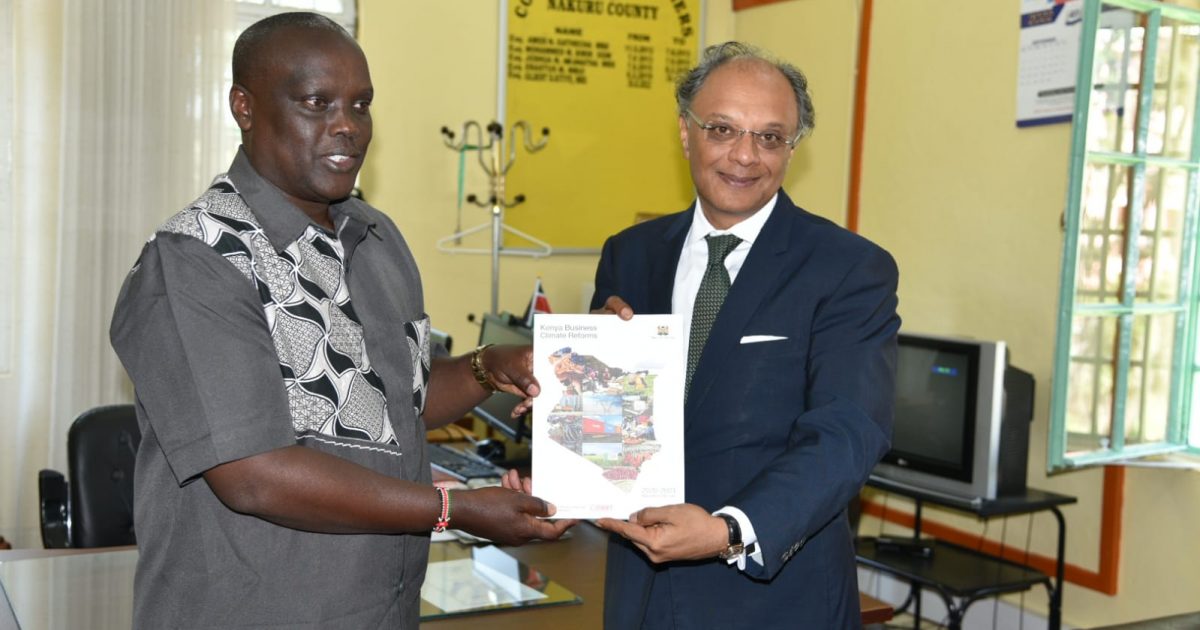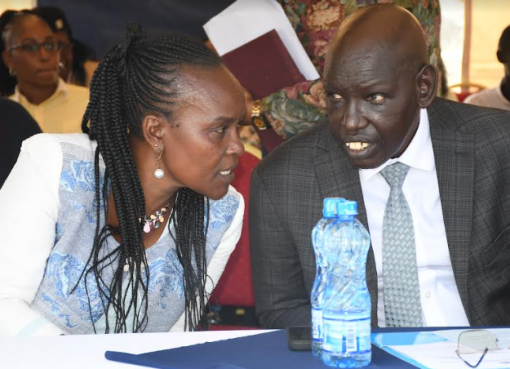Nakuru County Commissioner Gilbert Kitiyo has called for a coordinated effort to rationalize multiple levies and charges by county governments as a way of lowering cost of doing business and attracting investments in Kenya.
Kitiyo said some businesses were being slapped with multiple taxes and charges while traversing counties, a multiplicity that was affecting intra-county and inter-county trade in Kenya thereby discouraging investments while raising prices for the end user.
County governments, he added, need to come up with unlimited instruments to incentivize investors and provide a business-friendly environment.
He said the national government had undertaken major improvements that have made it easy to do business in Kenya.
Kitiyo, who made the remarks when Principal Secretary (PS) in the State Department of East Africa Community (EAC) Dr Kevit Desai paid him a courtesy call in his office, noted that some of the notable improvements by the national government have been in business registration services, availability of online services and digital payments system.
He added that the establishment of the Business Registration Service (BRS), the introduction of the e-Citizen platform, iTax and Huduma Centres remained core to making it easy to do business in Kenya.
“Policy makers at the County level should be asking themselves is registering a new business easy? Is getting construction permits easy? How long does it take to settle a commercial dispute? Is registering property easy? What about getting credit? Is paying levies easier?” suggested the administrator.
He said the devolved units were still encountering a number of challenges in regulating trade adding that there was need for collaboration with the national government which was better placed to give guidance.
“Payments to the national and county governments for concurrent services or no services at all in some instances are discouraging investments. County governments should coordinate with the national government before levying charges that may duplicate those set by the national government,” observed Kitiyo.
For most entrepreneurs and small business owners, the administrator observed, the main struggles revolved around lack of information and difficulties in resolving issues.
He indicated that most first time entrepreneurs seemed unaware of the permits and licenses required by the various regulators and by counties plus the charges.
“As a priority, the county governments and all regulatory bodies and service providers involved in supporting businesses need to make all their requirements easily understood. Further, all the services that businesses need should be easily accessible and painless to receive,” he said.
Kitiyo indicated that since Small and Medium Enterprises played an integral role in driving the economy of the country, the national government has made deliberate efforts to cater for this segment of businesses by undertaking various targeted initiatives.
For instance, he noted, the Companies Act of 2015 is targeted at single owner companies with few requirements, making them faster and efficient to set up.
There have been numerous waivers of fees for SMEs such as court filing fees for commercial disputes of up to Sh1 million, National Construction Authority (NCA) fees, National Environmental Management Authority (Nema) fees, and land search and registration fees. The Judiciary has also established the Small Claims Courts tasked with resolving SME disputes within 60 days of filing in order to free-up capital currently tied in disputes.
In his remarks, Dr Desai said the introduction of the Common External Tariff for the East African Community (EAC) partner states would catalyse Kenya’s manufacturing sector.
He added that the tariff would see innovation and gains in the manufacturing sector including increased production and value addition.
The new tariff took effect July 1, 2022. The agreement is that all member states of the EAC will cap their duty at 35 per cent for final or finished products.
The PS said the tariff would transform the manufacturing sector at all levels including textile, leather and finished products such as ketchup, steel and cement.
“This is one of the most important moments within the context of industrial development in the region. The total net effect will be across the value chain. It will be in the services, trade, as well as the manufacturers and will put a strong foundation within the context of our export-led interventions,” he noted.
The Principal Secretary said while this tariff was a huge shift in trade, it paves way for a brighter future.
Dr Desai urged fresh produce exporters and livestock farmers in Nakuru to take advantage of bilateral relations between Kenya-and her regional neighbours to grow the country’s market share in the East Africa Community market.
Nakuru mainly produces agricultural products such as milk, eggs, meat, fruits, flowers, vegetables, potatoes, and carrots.
“We need to access a larger share of this market in terms of fresh produce and what that means is that it translates to earning of foreign exchange in this country and we need to ensure that we push many products or facilitate trade to happen between Kenya and East Africa Community Member states so that we can increase the revenue earned in this particular relationship,” Dr Desai offered.
He stated that EAC member states were committed to putting in place clear and effective laws and regulations vital for ensuring best results for host economies, their citizens and investors.
“Foreign direct investment is critical for a country’s development, especially in times of economic crisis. It brings new and more committed capital, introduces new technologies and management styles, helps create jobs, and stimulates competition to bring down local prices and improve people’s access to goods and services,” noted the Principal Secretary.
By Jane Ngugi





